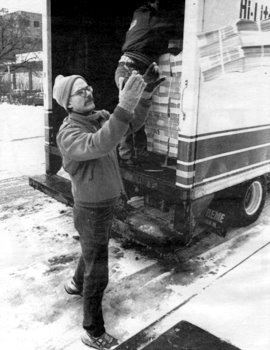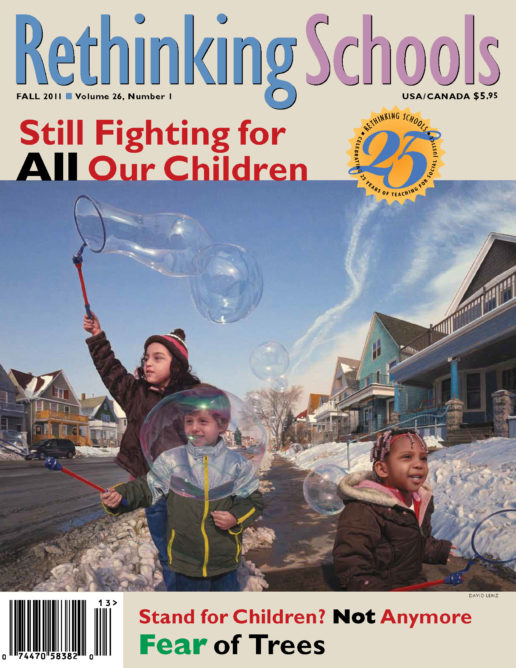The Birth of Rethinking Schools
Illustrator: Dave Schlabowske

Bob Peterson delivering Rethinking Schools, 1992.
I often say that Rethinking Schools began on my kitchen table with a can of rubber cement and an Apple IIe computer.
But that’s not exactly true. In some ways the publication started a year and half earlier in a study group of teachers and community activists who were struggling to figure out how to apply a generally progressive, left-leaning view of society to schools.
Having been a fan of book clubs and study circles ever since high school, in early 1985 I got together with some teacher friends to read Henry Giroux’s Theory and Resistance in Education. Giroux was one of several university educators writing about Paulo Freire and critical education theory. I had little trouble convincing eight people to join the study group, but had more trouble keeping them once we started plowing through the book. By the end of the second session people were complaining about the overly academic style; by the end of the third session people wereready to quit.
At the last formal meeting of our book group we talked very little about the book and a lot about how to move things in a progressive way in the Milwaukee Public Schools. The administration and school board were promoting increasingly scripted and “teacher-proof” curriculum, while the teachers’ union was focused on defending teachers’ rights as narrowly defined by the contract.
As progressive activists, we were tired of trooping down to the school board and testifying, only to be ignored. We wanted to go on the offensive—both politically and analytically. We were bored with the union newsletter, appalled at the superficial education coverage from Milwaukee’s daily newspapers, and viewed most academic education journals as irrelevant.
So a big topic of conversation at that meeting was the idea of putting out a publication, perhaps a newsletter, that dealt with educational issues in depth. Questions about objectives, format, audience, and process were discussed but left unresolved.
It was clear that, no matter what form the publication would take, we needed more people involved.
The next several meetings were larger, with as many as two dozen people. Despite our serious attempts, the gatherings were predominantly white with only a few African Americans and Latinos. The politics were all over the map—from those who wanted to “deschool society” in the spirit of free-school educator Ivan Illich, to promoters of Montessori schools, to people who felt little would change in schools before there was a social revolution.
At times the meetings were tense. We spent hours trying to unite around a concept and basic principles. Attendance shrank but meetings continued. As a result of patience and stubbornness, unity slowly emerged.
My housemate and co-troublemaker David Levine, bilingual teacher Rita Tenorio, education historian Bob Lowe, and English teacher Cynthia Ellwood played leading roles. Also essential to the project were Peter Murrell, a high school teacher; Terry Meier, an instructor at a local university; and Tony Baez, a community activist and leading proponent of bilingual education.
We decided to put out a tabloid newspaper with a clear focus on how policies in Milwaukee were affecting classrooms, teachers, and students. There would be a strong emphasis on multicultural education and a commitment to racial equality. We envisioned a somewhat bizarre hybrid journal that would combine theory and practice: Our perspective and articles would be grounded in teaching and organizing, and yet we would also print significant analytical articles.
The name of what we alternately called a “newspaper” or a “journal” was our next problem. How would we encapsulate our criticism of public schools; our desire for anti-racist, multicultural, engaging education; and our interest in both policy and teaching? It was Cynthia who came up with our name: Rethinking Schools. We realized that what we were really about was changing the institution of schools.
As we planned the first issue a couple of differences emerged, which in different forms have accompanied us over our quarter-century history. One tension was between being a “clearinghouse” for progressive education articles vs. a journal with a more coherent vision of social justice teaching and policy. Our ultimate decision to put forth a clear social justice vision served us well and helped distinguish us from other progressive education projects.
Another issue was what constituted a quality article. I wanted to capitalize on our momentum and get something out even if we compromised on quality. Bob Lowe, on the other hand, argued strongly and convincingly that articles had to be rigorous and well written with a thesis and supporting evidence, able to challenge and convince people who didn’t already agree with the article’s premise.
A third concern was the balance between classroom-based articles and those by academics.
We recognized that there was little point in debating these matters abstractly, so we applied our respective standards to particular articles. As we discussed the first set of articles, it became clear that the pieces that were to have constituted the first issue of Rethinking Schools were weak. In a sobering moment in April 1986, we pitched all of them and started over from scratch.
By early November we were in production with a new set of articles. We used my Apple IIe computer, Letraset rub-on letters for headlines, and lots of rubber cement. A couple of weeks later, we published 6,000 copies of our first edition with the front-page headline “Confessions of a Kindergarten Teacher: How I Survived Scott Foresman.” Our editorial criticized the “ritualistic and mechanical activities” of the basal, charging that “students experience reading as a drab prelude to equally drab paper and pencil activities. They come to view books as a source of boredom, rather than as a source of discovery and stimulation.” We argued that this “systems management” approach was “deskilling teachers,” robbing them of the opportunity to “grapple with the difficult tasks of figuring out what and how to teach.”
Starting with our second issue, we held bundling parties in my living room. Volunteers counted out papers, tying them with twine and labeling bundles for each of the 160 MPS schools, and for public libraries, stores, and community organizations. (Thank God, Post-it notes had been invented 10 years earlier.)
We started off modestly, as a letter dated Dec. 8, 1986, shows: “Since the publication of our first issue we have received over 35 subscription requests, raising almost enough money for the next issue.” Within only two and a half years, however, our print run skyrocketed from 6,000 to 20,000 and subscribers included the superintendent of schools, the mayor, and some members of the local school board.
First Steps Toward Expanding Our Reach
Although Rethinking Schools defined itself as a publication, we became a focal point for overlapping networks of progressive educational activists—from union reform activists, to curriculum reform advocates, to bilingual education supporters, to community activists concerned with the disproportionate numbers of African American students being suspended.
We soon began to question the balance of local and national coverage in Rethinking Schools. We wanted a national reach but we were rooted in a locality—Milwaukee—where there was significant grassroots activity both by progressive activists and school privatization advocates.
Part of the impetus for expanding our coverage was our growing relationship with the National Coalition of Education Activists, which Rethinking Schools editors had been instrumental in starting in 1988. As we brought on additional writers and eventually editors from around the country, including Bill Bigelow and Linda Christensen from Portland, Ore., and Stan Karp from New Jersey, we were able to provide quality, in-depth articles about teaching and policy issues outside of Milwaukee. We hired Mike Trokan, a longtime peace activist and organizer for the United Farm Workers, as business manager and rented a small office in the corner of the Milwaukee Peace Action Center.
In 1991, we hired journalist Barbara Miner as managing editor. Her skills as an experienced editor helped improve the quality of the magazine and her skills as an investigative journalist expanded our scope to include groundbreaking articles on vouchers, privatization, and the conservative Bradley Foundation. She also played a role in editing and producing several of our initial books.
Our capacity to build a national presence and maintain our local work depended, then as now, on the hard work of not only our small staff, but also volunteers, especially our volunteer editors and writers.
Books, Too
As the number of influential articles in the magazine grew, compiling them into books seemed a logical progression. Rethinking Columbus: Teaching About the 500th Anniversary of Columbus’s Arrival in the Americas, our first book, grew out of a popular set of articles in the magazinewritten by Bill Bigelow.
The first of the Columbus articles was written in the fall of 1989—three years before the Columbus quincentenary. In “Discovering Columbus: Re-Reading the Past,” Bill used the Columbus myth to encourage students to re-examine traditional interpretations of history. In the same issue, Rethinking Schools editorialized that the upcoming Columbus 500th anniversary provided a unique opportunity for progressive educators and parents to counter the racism and Eurocentrism that permeates the teaching of U.S. history, and to help develop a multicultural, anti-racist curriculum.
A year later Bigelow wrote a review of eight popular children’s books about Columbus and we started a regular column in our newspaper titled “Reconsidering Columbus.”
So when Rethinking Schools and the Network of Educators on Central America decided to co-publish Rethinking Columbus , we already had worked out our political perspective and purpose.
Our original conception was a 24-page pamphlet that would sell for as little as 10 cents. As we worked on the content, however, it became obvious that we needed to increase the number of articles so that the booklet would address a range of topics, including a re-evaluation of Columbus, current Native American issues, and a broader critique of U.S. history. It grew to a 96-page collection of articles and resources for educators, parents, and activists. Authors included Wendy Rose, Suzan Shown Harjo, Michael Dorris, Jimmie Durham, and N. Scott Momaday.
We printed 30,000 copies of Rethinking Columbus in September 1991,crossing our fingers that we would break even. The booklet sold out in three weeks. Before long, orders were pouring in from across the country and from as far away as Poland and India. By the time of the Columbus “celebration” in October 1992, approximately 200,000 copies had been sold—more than many books on the New York Times bestseller list.
More than anything else, the enormous popularity of Rethinking Columbus made us realize the hunger among teachers and teacher educators all over the country and beyond for social justice education. People wanted stories of how others were attempting critical teaching for social justice, they wanted resources and classroom-friendly materials. Rethinking Schools had an important role to play and a responsibility to play that role in the most creative, collaborative, respectful, and progressive way possible. We were on our way.

